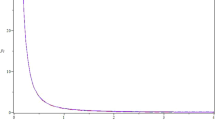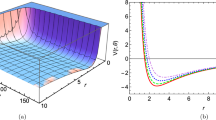Abstract
We have solved approximately Klein–Gordon equation with equal scalar and vector Mobius square plus Yukawa potentials in D-dimensions using the parametric form of Nikiforov–Uvarov method. Energy eigenvalues and corresponding wave functions in terms of Jacobi polynomials are obtained. We have also discussed some special cases of our potential.
Similar content being viewed by others
Avoid common mistakes on your manuscript.
1 Introduction
In relativistic quantum mechanics the particle motions are commonly described using either Klein–Gordon equation or Dirac equation [1, 2] depending on spin character of the particle. Klein Gordon equation is one of the most frequently used wave equation that describes spin-zero particles such as mesons. On the other hand, however, electrons are described satisfactorily by Dirac equation.
The solution of Klein–Gordon equation under different potentials plays an important role because one can understand physics that can be brought by such solutions. Among the most successful methods that have been used to solve Schrödinger, Dirac and Klein–Gordon equation, Nikiforov–Uvarov (NU) and supersymmetric quantum mechanics (SUSYQM) methods have great importance [3–13].
Recently Klein–Gordon equation with different potentials have been solved and investigated by different researchers [14–24]. For instance, Egrifes and Sever [25] have obtained bound state solutions of Klein–Gordon equation for generalized PT-symmetric Hulthen potential, Soylu et al. [26] considered Klein–Gordon equation under Rosen–Morse type potentials.
Aim of this paper is to obtain approximate solutions of Klein–Gordon equation with equal scalar and vector Mobius square plus Yukawa potentials in D-dimensional space.
2 Nikiforov–Uvarov (NU) method
Nikiforov–Uvarov method [8–11] is based on the solution of a generalized second order linear differential equation with special orthogonal function. Schrödinger equation
can be solved by this method. This can be done by transforming this equation into equation of hypergeometric type with appropriate transformation, S = S(x)
where σ(s) and \( \overline{\sigma } (s) \) must be polynomials of at most second-degree and \( \overline{\tau } (s) \) is a polynomial with at most first-degree. In order to find exact solution to Eq. (2) we set wave function as
On substituting Eq. (3) in Eq. (2), then Eq. (2) reduces to hypergeometric type,
where wave function Φ(s) is defined as logarithmic derivative [8]
where π(s) is at most first order polynomial. Likewise, hypergeometric type function χ(s) in Eq. (4) for a fixed n is given by Rodriques relation as
where B n is normalization constant and weight functions ρ(s) must satisfy the condition
with
In order to accomplish the condition imposed on weight function ρ(s), it is necessary that classical orthogonal polynomials τ(s) be equal to zero at some point of an interval (a, b) and its derivatives within this interval at σ(s) > 0 is negative, i.e.,
Therefore, function π(s) required for NU method are defined as follows:
k-value in Eq. (10) is possible to evaluate if the expression under square root is square of polynomials. This is possible if and only if its discriminant is zero. With this, new eigenvalues equation becomes
On comparing Eq. (11) with Eq. (12), we obtain energy eigenvalues.
Parametric generalization of NU method is given by generalized hypergeometric type equation as [27]
Eq. (13) is solved by comparing it with Eq. (20) and following polynomials are obtained
where
The resulting value of k in Eq. (15) is obtained from condition that function under square root must be square of a polynomials and it yields,
where
The new π(s) for each k becomes
For k − value as
Using Eq. (8), we obtain
The physical condition for bound state solution is τ′ < 0 and thus
With aid of Eqs. (11) and (12), we derive energy equation as
The weight function ρ(s) is obtained from e.g. Eq. (7) as
together with e.g. Eq. (6), we have
where
and \( P_{n}^{{\left( {\alpha ,\beta } \right)}} \) is Jacobi polynomial.
Second part of wave function is obtained from Eq. (5) as
where
Thus, the wave function is
3 Radial part of Klein–Gordon equation in D-dimensions
The radial part of Klein–Gordon equation in presence of vector and scalar potentials in D-dimensional space is written as [28–30]
For equal scalar and vector potentials Eq. (30) reduces to
Here, we consider Mobius square plus Yukawa potentials defined as [31, 32]
where V 0, V 1, A, B, C, D′ and α are constant coefficients. A good approximation for centrifugal barrier is taken as [33] (see Fig. 1)
which is valid for αr ≤ 1 when C = 1 and D′ = −1 [33–36], similar to other related works [37, 38]. In addition, when performing a power series expansion and setting α → 0, Eq. (33) gives the desired r −2 suggested by Greene and Aldrich [39]. By substituting Eqs. (32) and (33) into Eq. (31) we obtain
By a change of variable of the form
Eq. (34) is written as
where
By comparing Eq. (36) with Eq. (13), we obtain energy spectrum for Mobius square plus Yukawa potentials as
or more explicitly, we have,
where
wave function of the system is obtained as
4 Results and discussion
In order to test accuracy of our work, we compute numerical values for energy spectrum and graphical solutions. In Table 1, we have reported numerical values of energy for various states. Also, we have reported behaviour of energy in Fig. 2, We see that energy increases with increasing D. In Fig. 3, we show behaviour of energy versus alpha. It reveals that energy decreases as alpha decreases and tends to a constant value. Finally, energy has also been plotted versus the potential coefficients in Figs. 4 and 5. It shows well how energy increases for increasing V 0 and decreases for increasing V 1. Now a few special cases are discussed below. By adjusting some potential parameters, some well kwon potentials can be obtained. Setting V 0 = 0, C = 1, D′ = −1 into Eq. (32), Yukawa potential [32]
is obtained. Corresponding energy eigenvalues become
Similarly we set V o = 0, C = 1, D′ = −1 and α → 0 into Eq. (32), the potential reduces to Coulomb potential [37]
Corresponding energy eigenvalues become
where V 1 = 0, potential reduces to Mobius square potential. The generalized form of Mobius square potential can be written as
Comparing Eq. (46) with Deng–Fan potential [38]
for C = 1 and D′ = −1, we have V 0 A 2 = D e , V 0 AB = −D e (1 + b), V 0 B 2 = D e (1 + b)2, where \( b = e^{{\alpha r_{d} }} - 1 \) and r d is equilibrium inter-nuclear distance. Substitution of these parameters in Eq. (39) gives energy spectrum of Deng–Fan potential as
where
This result is consistent with that of Dong [38] when D = 3.
5 Conclusions
Approximate solutions of Klein–Gordon equation in case of equal scalar and vector Mobius square plus Yukawa potentials have been obtained using parametric form of NU method. By adjusting some parameters of potential in Eq. (3), three well known potentials are obtained. With a good approximation to centrifugal term, we have obtained energy eigenvalues and unnormalized wave function in terms of Jacobi polynomials. Numerical data for the energy spectrum are discussed indicating usefulness for other physical systems [40].
References
L Z Yi, Y F Diao, J Y Liu and C S Jia Phys. Lett. A 33 212 (2004)
X C Zhang, Q W Liu, C S Jia and L Z Wang Phys. Lett. A 340 59 (2005)
W C Qiang and S H Dong EPL 89 10003 (2010)
F A Serrano, X Y Gu and S H Dong J. Math. Phys. 51 082103 (2010)
S H Dong, A Gonzalez-Cisneros Ann. Phys. 323 1136 (2008)
S H Dong Factorization Method in Quantum Mechanics (Netherlands: Springer) (2007)
F Cooper, A Khare and U Sukhatme Phys. Rep. 251 267 (1995)
A F Nikiforov and V B Uvarov Special Functions of Mathematical Physics (Basel: Birkhaauser) (1988)
M G Miranda, G H Sun and S H Dong Int. J. Mod. Phys. E 19 123 (2010)
M C Zhang, G H Sun and S H Dong Phys. Lett. A 374 704 (2010)
H Hassanabadi, B H Yazaraloo and L L Lu Chin. Phys. Lett. 29 020303 (2012)
C S Jia, P Guo and X L Peng J. Phys. A Math. Gen. 39 7737 (2006)
C Deniz and M Gerçekliolu Indian J. Phys. 85 339 (2011)
W C Qiang and S H Dong Phys. Lett. A 363 169 (2007)
A D Alhaidari, H Bahlouli and A Al-Hasan Phys. Lett. A 349 87 (2006)
Z Q Ma, S H Dong, X Y Gu and J Yu Int. J. Mod. Phys. E 13 597 (2004)
S H Dong and M Lozada-Cassou Phys. Scr. 74 285 (2006)
W C Qiang and S H Dong Phys. Lett. A 372 4789 (2008)
A D Antia, A N Ikot, I O Akpan, O A Awoga Indian J. Phys. 87 155 (2013)
I O Akpan, A D Antia and A N Ikot ISRN High Energy Phys. 2012 798209 (2012)
A D Antia, A N Ikot, E E Ituen and I O Akpan Sri Lankan J. Phys. 13 27 (2012)
A N Ikot, L E Akpabio and E J Uwah EJTP 25 225 (2011)
A N Ikot, A B Udoimuk and L E Akpabio Am. J. Sci. Ind. Res. 2 179 (2011)
T Chen, Y F Diao and C S Jia Phys. Scr. 78 065014 (2009)
H Egrifes and R Sever Int. J. Theor. Phys. 46 935 (2008)
A Soylu, O Bayrak and I Boztosun Chin. Phys. Lett. 25 2754 (2008)
C Tezcan and R Sever Int. J. Theor. Phys. 48 337 (2009)
H Hassanabadi, B H Yazarloo, S Zarrinkamar and H Rahimov Commun. Theor. Phys. 57 339 (2012)
L L Lu, B H Yazarloo, S Zarrinkamar, G Liu and H Hassanabadi Few Body Syst. 53 573 (2012)
S H Dong Wave Equations in High Dimensions (Netherlands: Springer) (2011)
P Boonserm and M Visser JHEP 2011 73 (2011)
H Yukawa Proc. Phys. Math. Soc. Japan 17 48 (1935)
B H Yazarloo, H Hassanabadi and S Zarinkarmar Eur. Phys. J. Plus 127 51 (2012)
W C Qiang and S H Dong Phys. Lett. A 368 13 (2007)
S H Dong, W C Qiang, G H Sun and V B Bezerra J. Phys. A 40 10535 (2007)
G F Wei, C Y Long and S H Dong Phys. Lett. A 372 2592 (2008)
W Greiner Relativistic Quantum Mechanics Wave Equations (Berlin: Springer) (2000)
S H Dong Commun. Theor. Phys. 55 969 (2011)
R L Greene and C Aldrich Phys. Rev. A 14 2363 (1976)
A N Ikot, B H Yazarloo, A D Antia and H Hassanabadi Indian J. Phys. doi:10.1007/12648-013-0306-4 (2013); Z Azimzadeh, A R Vahidi and E Babolian Indian J. Phys. 86 721 (2012); A Biswas and E V Krishnan Indian J. Phys. 85 1513 (2011)
Author information
Authors and Affiliations
Corresponding author
Rights and permissions
About this article
Cite this article
Antia, A.D., Ikot, A.N., Hassanabadi, H. et al. Bound state solutions of Klein–Gordon equation with Mobius square plus Yukawa potentials. Indian J Phys 87, 1133–1139 (2013). https://doi.org/10.1007/s12648-013-0336-y
Received:
Accepted:
Published:
Issue Date:
DOI: https://doi.org/10.1007/s12648-013-0336-y









